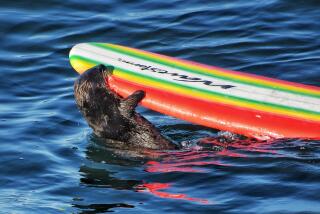On sea otters, we need to see the big picture
- Share via
When we think of predators, we don’t usually think of sea otters, those cute, furry creatures seen in televised nature specials or on visits to aquariums. But that’s what they are, situated near the top of the marine food chain, and their story illustrates the conflict between mankind and all top-level predators, as well as the need to expand our view of the financial and environmental benefits these creatures confer.
Sea otters once abounded in coastal waters around the North Pacific Coast from Russia to Mexico. Over decades, they were hunted to near-extinction as a popular target of the maritime fur trade. Yet their dramatic brush with extinction, along with their intrinsically appealing characteristics, has provided a powerful emotional foundation for otter recovery efforts in the United States.
While these conservation initiatives have shown impressive results, they have also created conflicts with fishermen over valuable shellfish resources such as clams, mussels and abalone, traditional food sources for these small predators. The competing priorities of aiding otter recovery and support for ailing coastal fishing communities appear on a collision course.
Concern over the loss of charismatic, top-level predators, including lions and sharks, has spurred numerous protection efforts, followed in some cases by recovery. But the dark side of the resulting conservation success is that the return of such species at the top of the food chain has also led to conflicts over shared resources. In the oceans, these struggles revolve around commercial and recreational fisheries.
The seemingly conflicting values of preserving an important element of nature’s biodiversity versus our reluctance to incur the associated costs can be at least partly resolved through a better understanding of the greater ecological services provided by many of these animals. Otters, now at the center of some rather large national policy debates, offer an example.
Leaders in Washington are considering several important but highly contentious and contrasting policy decisions. One is a proposal by the U.S. Fish and Wildlife Service to eliminate the 24-year-old Southern California “no-otter zone” designation under which any otters are captured and relocated. At the same time, a bill in Congress would allow resumption of trade in fur from sea otters that are trapped for subsistence in southeast Alaska, in an effort to reduce the competition between humans and otters over key local shellfish fisheries.
In nearly every case in which recovery of a predator is occurring or has been proposed, the policy debate is framed as a contrast between ethical and monetary values: a choice between our hearts and our wallets. Yet the many scientifically known and suspected positive influences of these animals on the health of regional ecosystems are all too often overlooked. Indeed, research has shown that these ecological services provide very real dollars-and-cents benefits for society that policymakers should take into consideration.
For instance, kelp forests are the foundation of many North Pacific marine ecosystems. These wildernesses of the deep support regional fish populations, serving both as a vital habitat and a source of nourishment for many species. Perhaps even more important, research indicates that these forests also provide humans with a number of crucial natural services. Their role in helping to buffer shorelines from wave exposure, reducing rates of coastal erosion and shoreline recession, is just one example. And sea otters are essential to keeping these coastal kelp forests healthy.
Much like the way wolves cull deer and elk populations on land, sea otters eat urchins. But when otter populations are allowed to plummet, urchins are left unchecked. Without any natural predators, urchins can become so numerous that they overgraze the lush kelp forests that otherwise abound along the West Coast. When this happens, the lost ecological benefits — both to society and the environment — are dramatic.
An ever-growing body of research shows that the ecological and economic influences of predators in nature, from sea otters to wolves, extend well beyond the things they eat. Although debates over managing these species are likely to always be controversial, invoking deep passions on both sides, science provides the best basis for policy decisions, as it affords a common currency in valuing the perceived costs and benefits for predator conservation.
James A. Estes is a professor with the Department of Ecology and Evolutionary Biology at UC Santa Cruz, and a Pew marine fellow.
More to Read
A cure for the common opinion
Get thought-provoking perspectives with our weekly newsletter.
You may occasionally receive promotional content from the Los Angeles Times.









